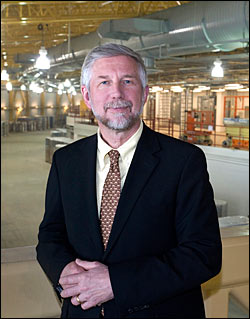A Note from Steve Dierker
December 13, 2011

Earlier this month, a Rembrandt painting received the official stamp of authenticity by the Rembrandt Research Project. Based in the Netherlands, this organization is considered by the art world to be the final arbiter of whether or not a painting is a genuine Rembrandt. The announcement was made at a press conference in Amsterdam.
That same painting, titled “Old Man with a Beard,” spent a day here at NSLS in 2009. Users on the experimental floor will remember the cluster gathered around the Maia detector at beamline X7A, their every move recorded by a documentary film crew.
It was a day’s work worth preserving. The Maia detector produced high-definition maps of the spatial distribution of different chemical elements in the painting.
Recalled Photon Sciences physicist Pete Siddons, “After doing the experiments at NSLS, I felt that the painting I held in my hands was a genuine Rembrandt. We had identified hidden paint layers, which the art historians considered critical to determining attribution.”
Siddons spent eight years developing the Maia detector with collaborators at Australia’s Commonwealth Scientific and Industrial Research Organisation, that country’s national science agency. Maia won an R&D 100 Award earlier this year.
Here in the U.S., Maia’s development was supported by the Department of Energy. Specifically, Pete’s detector work is funded by the Office of Basic Energy Sciences (BES) within DOE’s Office of Science. BES plays a critical role in supporting detector development for research in a range of scientific disciplines, including materials science, physics, chemistry, and medicine. BES, of course, also funds NSLS operations and NSLS-II and NEXT construction.
Maia was not made to study works of art. As Pete says, it was developed to address the challenges experienced by all x-ray microprobes with poor detector performance, including difficulties in examining statistically significant areas of highly inhomogeneous samples, such as those found in environmental samples or complex materials used in energy conversion. The day with the Rembrandt gave our scientists a chance to show off the capabilities and versatility of the Maia detector, which has revolutionized our ability to do high-speed spectroscopic imaging. Maia has quickly gained fame in the synchrotron community and is in demand at facilities around the world. Several beamlines at NSLS-II plan on using it.
I invite you to read the details of this fascinating story, posted on the Photon Sciences homepage and carried later in this issue of Photon Sciences eNews.
The documentary crew I mentioned above produced a movie on the scientific analysis of art. Donald Sutherland is the narrator. For us in Photon Sciences, the star of the show is the Maia detector at NSLS. I have heard that the documentary will have its first public screening some time in January 2012, in New York City. You can watch a trailer here.
2011-2768 | INT/EXT | Newsroom









